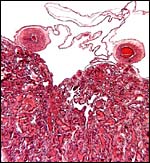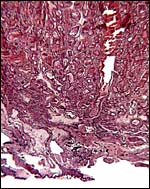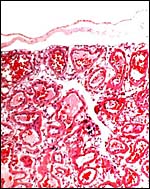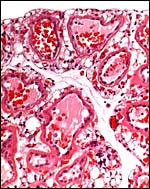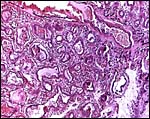| (Clicking
on the thumbnail images will launch a new window and a larger version
of the thumbnail.) |
| Last
updated: Jan. 31, 2004. |
Amblonyx(Aonyx) cinerea
Order - Carnivora
Family - Mustelidae
1) General Zoological Data
This Asiatic species is considerably smaller than the two African clawless otters; it is the smallest otter species and weighs only 1-5 kg as adult. Several subspecies are recognized. There is still controversy over the genus name of this and the African clawless otters. Not wishing to participate in this debate, I list both genera here. This is an endangered species that feeds primarily on crustaceans, less on fish and is primarily nocturnal. The species extends from India to Indonesia and is in the foot Himalayan foothills (Nowak, 1999). Longevity in captivity is at least 16+ years. Small-clawed otter are fairly commonly displayed in zoos and have also readily bred in captivity. There are problems, however, in rearing young that are well described by Leslie (1970).The species designation comes from: amblus(Gr.)=blunt (without) and onux(Gr.)=claw; cinerea(L.)=ash-colored (Gotch1979).
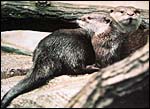 |
Aonyx cinerea at Cologne Zoo (Courtesy Zoo Köln, Germany). |
Amblonyx pairs mate for life with a gestation period that lasts 60-64 days. One to six young are produced (Nowak, 1999). Newborns weigh around 50 g. The placenta available to me came from a newborn at San Diego Zoo. The dam had delivered six liveborn and one stillborn fetuses, one was accompanied by the placenta. The female newborn weighed 41 g and the placenta was oval, measured 9 x 4 cm and had a deep red appearance with smooth surfaces. Its weight was not determined. Mossman (1987) no doubt would classify this as being "interrupted zonary". Also, grossly no hemophagous organ was seen, nor was it present microscopically; this region, however, has been observed in all described mustelids and is sometimes very large. And it was also no bilobed, as that of the zorilla (Rau, 1925).
3)
Implantation
Implantation of mustelid placentas occurs mesometrially, the placenta
developing various shapes (Mossman, 1987). Timing of this species' implantation
has not been described; indeed, there is virtually no reproductive knowledge
of Aonyx.
4) General Characterization of the Placenta
This is a labyrinthine, endotheliochorial placenta. The various zones
described zorilla and other mustelids (transitional, labyrinthine etc.
are not readily identified as the following figures will demonstrate.
This is a lamellar, labyrinthine, endotheliochorial organ. The villi are covered by a single layer of cuboidal trophoblast without any major different cell types. Amoroso (1961) refers to the trophoblast as "syntrophoblast", but I am not certain that there is truly fusion of trophoblast, and no fine structural detail is available. The villi are composed of very delicate fibrous tissue with tiny capillaries.
Regrettably, these data were not collected when the specimen was examined. That is information is needed in future.
7) Uteroplacental circulation
No studies have been done in this species.
8) Extraplacental membranes
There is a large allantoic sac. Although it is stated that mustelids retain a large yolk sac (Mossman, 1987), none was observed in this specimen.
 |
Allantoamnion, not too well preserved. |
At the base of the placenta, the junctional zone is composed of debris, some endometrial glandular secretions, fresh blood from detachment and irregular trophoblast. A few decidual cells are intermixed.
10) Endometrium
Otters have a bicornuate uterus with long horns and a short body. There is not much decidua formed. Degenerated decidual cells are intermixed in the debris of the junctional zone shown below.
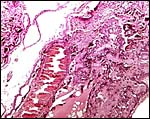 |
Junctional zone at base of placenta, site of detachment from uterus. |
None.
12) Endocrinology
I am not aware of any endocrine studies in Aonyx.
Amblonyx cinerea has 38 chromosomes (Hsu & Benirschke, 1968). Hybrids have not been described.
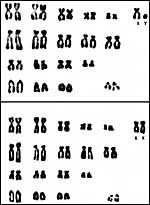 |
Karyotypes of male and female clawless otters. |
I am not aware of any studies.
15) Pathological features
Cyanide toxicity killed two clawless otters in a zoo from having eaten seeds of loquat (Eriobotrya japonica) (Weber & Garner, 2002). Griner (1983) identified a number of parasites in "Malayan" otters but felt that glomerulosclerosis and gastric ulcers were more problematic, as were some bacterial infections. In captivity, obesity is a potential problem. The fetus from this placenta had aspirated meconium and vernix and was otherwise only unusual in having remarkably much glycogen in its liver cells. Although the fetus had meconium aspiration, the fetal surface was not green.
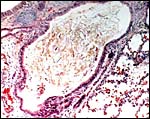 |
This is the neonatal lung with aspirated meconium. |
The metabolic rates of clawless otters was determined at rest and whilst swimming by Borgwardt & Culik (1999).
 |
The multilobulated neonatal kidney. |
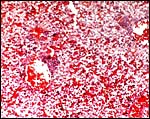 |
The liver of this neonate had a large amount of glycogen in the liver cell cytoplasm and minimal hematopoiesis. |
Several cell strains of small-clawed otters are available from CRES at the San Diego Zoo by contacting Dr. Oliver Ryder at oryder@ucsd.edu.
18) Other remarks - What additional
Information is needed?
More term placentas need to be studied, their weight is yet unknown and
there are no reports on the umbilical cord. Endocrine studies are also
lacking. No implantational stages are reported.
Acknowledgement
I am grateful for the animal photograph in this chapter that comes from
the Cologne Zoo, Germany and was taken by Rolf Schlosser. I am thus grateful
to Professor G. Nogge for allowing me to show it here.
References
Amoroso, E.C.: Placentation. Chapter 15, pp.127-311, In, Marshall's Physiology
of Reproduction, V.II, A.S. Parkes, ed. Second Edition. Little, Brown
& Co. Boston, 1961.
Borgwardt, N. and Culik, B.M.: Asian small-clawed otters (Amblonyx cinerea): resting and swimming metabolic rates. J. Comp. Physiol B 169:100-106, 1999.
Gotch, A.F.: Mammals - Their Latin Names Explained. Blandford Press, Poole, Dorset, 1979.
Griner, L.A.: Pathology of Zoo Animals. Zoological Society of San Diego, San Diego, California, 1983.
Hsu, T.C. and Benirschke, K.: An Atlas of Mammalian Chromosomes. Vol. 2, Folio 72. Springer-Verlag, N.Y. 1968.
Leslie, G.: Observations on the Oriental short-clawed otter Aonyx cinerea at Aberdeen Zoo. Intern. Zoo Ybk. 10:79-81, 1970.
Mossman, H.W.: Vertebrate Fetal Membranes. MacMillan, Houndmills, 1987.
Nowak, R.M.: Walker's Mammals of the World. 6th ed. The Johns Hopkins Press, Baltimore, 1999.
Rau, A.: Contributions to our knowledge of the structure of the placenta of mustelidae, ursidae, and sciuridae. Proc. Zool. Soc. London 25:1027-1070, 1925.
Weber,
M.A. and Garner, M.: Cyanide toxicosis in Asian small-clawed otters (Amblyonix
cinereus) secondary to ingestion of loquat (Eriobotrya japonica).
J. Zoo Wild. Med. 33:145-146, 2002.



